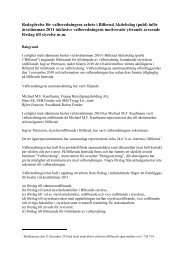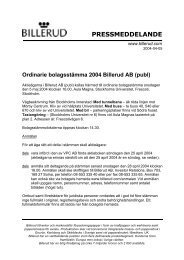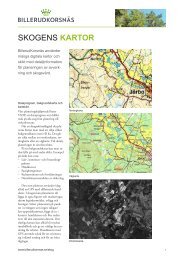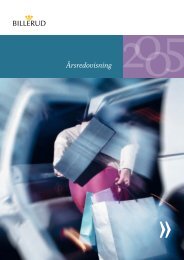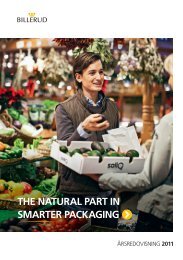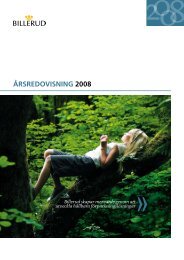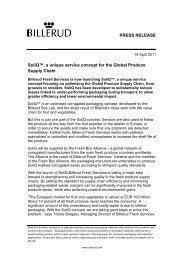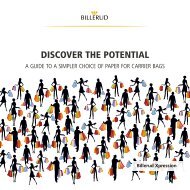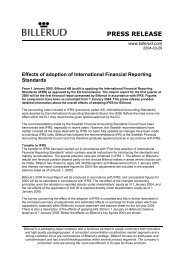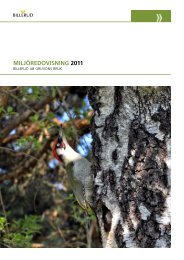Korsnäs dEsign
Korsnäs dEsign
Korsnäs dEsign
Create successful ePaper yourself
Turn your PDF publications into a flip-book with our unique Google optimized e-Paper software.
Environmental Product Declaration<br />
<strong>Korsnäs</strong> Light<br />
This declaration has been compiled by:<br />
IVL Swedish Environmental Research Institute Ltd.<br />
Environmental<br />
Product Declaration<br />
<strong>Korsnäs</strong> design<br />
<strong>Korsnäs</strong> Light is XXXX<br />
XX<br />
XX<br />
XXXX<br />
<strong>Korsnäs</strong> AB<br />
PO Box<br />
SE- Sweden<br />
Corporate identity number:<br />
Contact: XX tel. +46, xx@korsnäs.se<br />
For further information visit www.korsnas.com<br />
This is an Environmental Product Declaration of <strong>Korsnäs</strong> Light,<br />
registered in the International EPD System (www.environdec.com).<br />
The declaration has been developed based on the results of a<br />
Life Cycle Assessment (LCA) and the Product Category Rules for<br />
Processed paper and paperboard (PCR 3214).<br />
The results are divided into Upstream (raw material, energy and<br />
packaging production), Core (pulp and paperboard production)<br />
and Downstream (transport to an average European customer<br />
and waste management) processes.<br />
Manufacturer<br />
<strong>Korsnäs</strong> AB is one of northern Europe’s leading manufacturers of XX. <strong>Korsnäs</strong> AB was<br />
established in XX in XX. Today we are established in XX, XX and XX, in addition to Sweden. <strong>Korsnäs</strong> manufacturing<br />
plant in XX is certified in accordance with ISO XX and ISO XX.<br />
Functional Unit<br />
One tonne of product at an average consumer in Europe<br />
This is an Environmental Product Declaration for <strong>Korsnäs</strong> Design, registered in the International EPD System<br />
Validity of the EPD<br />
(www.environdec.com). The The declaration geographical has area been and developed the time during based which on the the EPD results is valid of shall a Life be Cycle reported Assessment in the EPD.<br />
(LCA) and the Product Category EPDs from Rules different for Processed programmes paper may not and be paperboard comparable. (PCR 3214).<br />
Information and data given in this EPD can be used as upstream data by a customer who will perform a new<br />
EPD within the system boundaries given in a related PCR.<br />
contact<br />
Agneta Rognli, Manager, Business Communication<br />
phone +46 (0)26 15 10 00<br />
agneta.rognli@korsnas.com<br />
For further information visit www.korsnas.com
korsnäs AB<br />
<strong>Korsnäs</strong> AB is one of the world’s leading producers<br />
of virgin fibre-based packaging material, primarily<br />
for consumer products. Production is conducted at<br />
the production sites in Gävle, Frövi and Rockhammar,<br />
all in Sweden.<br />
Production capacity amounts to 1.1 million<br />
tonnes of cartonboard and paper annually, with<br />
integrated pulp production. The range of products<br />
includes Liquid Packaging Board, Cartonboard,<br />
White Top Kraftliners and Sack- and Kraftpaper.<br />
The fibre content in <strong>Korsnäs</strong>’ packaging material<br />
is based on 100% renewable fibres. <strong>Korsnäs</strong>’<br />
operations have an impact on the environment<br />
through forestry management, use of resources<br />
like energy, chemicals, water and air, and emissions<br />
to water and air.<br />
<strong>Korsnäs</strong>’ industrial operations are fully certified<br />
in accordance with<br />
• ISO 9001:2008 and ISO 14001:2004, Quality and<br />
environment management<br />
• FSC CoC/CW and PEFC CoC, FSC and PEFC Forest<br />
management<br />
• SS 627750, Ed 1, Energy management<br />
• BRC/IOP, Hygiene management<br />
declaration of contents<br />
claycoating – for excellent printing results<br />
ECF-bleached fibres – for good printing<br />
results and surface smoothness<br />
unbleached fibres – for strength<br />
<strong>Korsnäs</strong> design<br />
<strong>Korsnäs</strong> Design is a fully coated, 100 % virgin fibre<br />
based white top kraftliner with an excellent print<br />
surface for high quality images and eye-catching<br />
effects. The even print surface gives minimal<br />
variations in colour reproduction, high gloss and a<br />
good printing economy. <strong>Korsnäs</strong> Design is used for<br />
premium corrugated packaging applications and is<br />
mainly developed for pre-print in flexo and offset.<br />
However, this product is extensively used also for<br />
post-print applications with flexo, screen, digital<br />
and offset print. With 100 % virgin fibre content<br />
<strong>Korsnäs</strong> Design offers high resistance to moisture<br />
and suitability for direct food contact. Typical<br />
applications are shelf-ready packaging and display<br />
solutions for premium brands. <strong>Korsnäs</strong> Design is<br />
available in grammages between 130 gsm* and<br />
200 gsm. <strong>Korsnäs</strong> Design is produced at the mill<br />
in Gävle.<br />
*gsm = g/m 2<br />
2
System boundaries<br />
The international EPD system is based on a<br />
hierarchic approach based on the international<br />
standards:<br />
• ISO 9001, Quality management system<br />
• ISO 14001, Environmental management system<br />
• ISO 14044, LCA – Requirements and guidelines<br />
• ISO 14025, Type III environmental declarations<br />
The systems are divided into three life cycle phases:<br />
Upstream: Forestry, production of fertilisers,<br />
production of energy wares, production of chemicals,<br />
auxiliary products and other raw materials,<br />
production of transport packaging.<br />
Core: Transportation of all materials (including<br />
wood) to the core processes, production of pulp,<br />
production of paper and paperboard, cutting and<br />
packing of the products and treatment of waste<br />
generated from the production processes.<br />
Downstream: Distribution of the product and<br />
waste management of transport packaging.<br />
Upstream module<br />
Plans, energy<br />
wares, fertilisation<br />
Raw material<br />
Raw material<br />
Transport<br />
Transport<br />
Transport<br />
Forestry<br />
Energy wares<br />
Other products<br />
and raw material<br />
Transport<br />
packaging<br />
Transport<br />
Transport<br />
Transport<br />
Transport<br />
Core module<br />
Pulp, paper and board<br />
production, coating, cutting etc<br />
Transport<br />
Waste management of<br />
production wastes<br />
Downstream module<br />
Transport<br />
Average converter<br />
(not included)<br />
Transport<br />
Waste management of<br />
transport packaging<br />
Use of final product<br />
(not included)<br />
Transport<br />
Waste management of<br />
final product (not included)<br />
Data included<br />
data not included<br />
3
Environmental Performance<br />
The environmental impact of three selected<br />
grammages representing a low, medium and high<br />
grammage within the product range are presented<br />
in the table below.<br />
The declared unit is one tonne (1000 kg) of<br />
the product delivered at the gate of an average<br />
converter/customer in Europe. As additional<br />
information, the environmental impact is stated<br />
also per 1000 m 2 .<br />
The carbon footprint (greenhouse gas emissions<br />
over the life cycle) is presented in the following<br />
diagram as global warming potential 100 years<br />
(GWP100) in kg CO 2<br />
equivalents per tonne product.<br />
Greenhouse Gas Emissions korsnäs design 145 gsm<br />
kg CO 2<br />
e/tonne<br />
700<br />
600<br />
500<br />
400<br />
300<br />
200<br />
100<br />
0<br />
Forestry<br />
raw materials<br />
energy<br />
packaging materials<br />
transports to mill<br />
board/paper mill<br />
distribution and waste<br />
transport packaging<br />
total<br />
upstream<br />
core<br />
downstream<br />
total<br />
Environmental Impact<br />
<strong>Korsnäs</strong> design<br />
upstream Core downstream Total total<br />
korsnäs Design 130 gsm kg/tonne kg/tonne kg/tonne kg/tonne kg/1000 m 2<br />
Global warming CO 2<br />
eq. 340 250 50 640 83<br />
Acidification SO 2<br />
eq. 2.1 2.1 0.10 4.3 0.56<br />
3-<br />
Eutrophication PO 4<br />
eq. 0.39 0.88 0.021 1.3 0.17<br />
Ozone-depletion CFC-11 eq. 2.3E-05 3.8E-08 1.2E-06 2.4E-05 3.1E-06<br />
Photochemical oxidant formation C 2<br />
H 4<br />
eq. 0.30 0.074 0.015 0.38 0.049<br />
korsnäs Design 145 gsm<br />
Global warming CO 2<br />
eq. 310 240 50 610 88<br />
Acidification SO 2<br />
eq. 2.0 2.0 0.10 4.1 0.59<br />
3-<br />
Eutrophication PO 4<br />
eq. 0.36 0.88 0.021 1.3 0.19<br />
Ozone-depletion CFC-11 eq. 2.1E-05 3.6E-08 1.2E-06 2.2E-05 3.2E-06<br />
Photochemical oxidant formation C 2<br />
H 4<br />
eq. 0.27 0.072 0.015 0.36 0.052<br />
korsnäs Design 200 gsm<br />
Global warming CO 2<br />
eq. 290 240 50 590 118<br />
Acidification SO 2<br />
eq. 1.9 2.0 0.10 4.0 0.80<br />
3-<br />
Eutrophication PO 4<br />
eq. 0.36 0.81 0.021 1.2 0.24<br />
Ozone-depletion CFC-11 eq. 1.9E-05 3.6E-08 1.2E-06 2.0E-05 4.0E-06<br />
Photochemical oxidant formation C 2<br />
H 4<br />
eq. 0.25 0.070 0.015 0.34 0.068<br />
4
use of resources<br />
The following table presents the total resources used for production and distribution of three<br />
selected grammages representing a low, medium and high grammage within the product range.<br />
Additional information on the use of resources split into the upstream, core and downstream<br />
phases is available on request.<br />
korsnäs korsnäs korsnäs<br />
Natural material resources, renewable design 130 design 145 design 200 unit<br />
Biomass 4.1 3.8 3.9 m 3 s.u.b/tonne<br />
Natural material resources, non-renewable<br />
Inert rock 93 85 78 kg/tonne<br />
Sodium chloride (rock salt) 37 38 36 kg/tonne<br />
Limestone (calcium carbonate) 85 76 63 kg/tonne<br />
Kaolinite (24% in ore as mined) 110 94 72 kg/tonne<br />
Natural Aggregate 13 13 12 kg/tonne<br />
Gravel 18 17 18 kg/tonne<br />
Other 32 31 28 kg/tonne<br />
Energy resources, renewable<br />
Energy, biomass 4200 4000 4100 MJ/tonne<br />
Energy, hydropower 2300 2300 2200 MJ/tonne<br />
Energy resources, non-renewable<br />
Nuclear energy, Uranium 7400 7200 7300 MJ/tonne<br />
Crude oil 5600 5400 5200 MJ/tonne<br />
Natural gas 2800 2500 2300 MJ/tonne<br />
Hard coal 1100 1100 1000 MJ/tonne<br />
Other* 480 470 440 MJ/tonne<br />
*Other refers to resources used in amounts less than 5% of the total.<br />
Other Indicators<br />
The electricity consumption and waste over the life cycle are specified in the tables below.<br />
korsnäs korsnäs korsnäs<br />
Indicator, input design 130 design 145 design 200 unit<br />
Electricity consumption at manufacturing* 980 950 970 kWh/tonne<br />
Water use at manufacturing 96 95 93 m 3 /tonne<br />
Indicator, output<br />
Material subject for recycling 23 23 23 kg/tonne<br />
Hazardous waste 0.062 0.063 0.062 kg/tonne<br />
Other waste 250 230 230 kg/tonne<br />
*Electricity use is also presented as “Energy resources” above.<br />
5
Additional Environmental Information: Potential Environmental gain<br />
Waste minimisation All <strong>Korsnäs</strong> products are based<br />
on virgin fibres with high strength properties enabling<br />
packaging weight to be reduced.<br />
Recyclability and recovery <strong>Korsnäs</strong> Design is<br />
recoverable through material recycling and energy<br />
recovery in accordance with the material requirements<br />
stipulated in EN 13430:2004 and EN 13431:2004.<br />
Waste handling All board and paper products<br />
produced by <strong>Korsnäs</strong> meet the targets specified in<br />
the EU’s waste management hierarchy within the<br />
EU Waste Framework Directive (2006/12/EC) as well<br />
as the essential requirements of the EU Packaging<br />
Waste Directive 94/62/EC.<br />
Biodegradable <strong>Korsnäs</strong> products are based on<br />
pulp consisting of cellulose, hemicellulose and some<br />
lignin which will be degraded by microorganisms in<br />
nature. The decomposition time required depends<br />
on several factors such as temperature, humidity,<br />
pH and microbiological activity.<br />
Uptake of carbon dioxide in growing forests<br />
Carbon stocks are increasing in Swedish forest<br />
ecosystems, mainly in the living biomass, due to<br />
the fact that the forest growth rate is higher than<br />
the harvest rate. The high growth rate is a result<br />
of efficient and sustainable forest management.<br />
The long-term forest management is to a large<br />
extent driven by the demand for round wood from<br />
the forest industry. The net sequestration (removal)<br />
of biogenic carbon dioxide is calculated based on<br />
the share of the net growth of the photosynthesis<br />
that is allocated to the board. Future scenarios for<br />
harvest rates in Sweden over the next 20 years<br />
conclude that the harvest rate will remain significantly<br />
lower than the growth rate. Note that that the<br />
system boundary settings used to calculate the net<br />
sequestration (removal) of biogenic carbon dioxide<br />
represent forest management and therefore differ<br />
from the product related boundary settings used<br />
elsewhere in the EPD.<br />
korsnäs korsnäs korsnäs<br />
design 130 design 145 design 200 Unit<br />
Net sequestration (removal) of biogenic CO 2<br />
in forests -2900 -2700 -2800 kg CO 2<br />
e/tonne<br />
Detailed environmental information<br />
Below follows a list of detailed emission parameters, some of which are already accounted for in the<br />
environmental impacts presented above. More detailed information is available on request.<br />
korsnäs design 130 korsnäs design 145 korsnäs design 200<br />
Emissions to air* kg/tonne kg/tonne kg/tonne<br />
Carbon dioxide, CO 2<br />
fossil 600 580 560<br />
NOx as NO 2<br />
3.3 3.1 3<br />
Sulphur dioxide, SO 2<br />
2.7 2.5 2.4<br />
Emissions to water*<br />
COD 23 23 21<br />
Phosphorus as P 0.028 0.029 0.026<br />
Nitrogen as N 0.53 0.53 0.5<br />
Suspended solids 5.6 5.6 5.1<br />
AOX 0.095 0.096 0.087<br />
korsnäs design 130 korsnäs design 145 korsnäs design 200<br />
Emissions to air* kg/1000 m 2 kg/1000 m 2 kg/1000 m 2<br />
Carbon dioxide, CO 2<br />
fossil 79 84 110<br />
NOx as NO 2<br />
0,42 0.45 0.6<br />
Sulphur dioxide, SO 2<br />
0,35 0.37 0.49<br />
Emissions to water*<br />
COD 3 3.4 4.2<br />
Phosphorus as P 0.0037 0.0041 0.0052<br />
Nitrogen as N 0.069 0.077 0.1<br />
Suspended solids 0.73 0.81 1<br />
AOX 0.012 0.014 0.017<br />
*The environmental impact of these emissions is already presented under environmental impact above.<br />
6
<strong>Korsnäs</strong> climate programme<br />
<strong>Korsnäs</strong> is actively pursuing improvements to minimise<br />
the environmental impact. Through an extensive climate<br />
programme, <strong>Korsnäs</strong> has made and will continue to make<br />
major investments in resource optimisation in order to<br />
reduce the need for fossil fuels. Investments presently<br />
implemented or planned are:<br />
• New evaporation plant in Gävle (2010)<br />
• Exchange of fossil fuel in lime kiln to biofuel in<br />
Frövi (2010)<br />
• Increase cooperation with the municipality of<br />
Lindesberg for local heating (2011)<br />
• A joint venture with Gävle municipality for a new<br />
bioenergy plant to provide district heating (2012)<br />
References<br />
Eriksson, E., Karlsson, P-E., Hallberg, L., Jelse, K.,<br />
Carbon Footprints of Cartons in Europe – Carbon<br />
Footprint Methodology and biogenic carbon<br />
sequestration, IVL Swedish Environmental Research<br />
Institute, B1924, 2010<br />
Jelse K. & Palm D., 2010, Life cycle assessment<br />
of <strong>Korsnäs</strong> virgin fibre-based packaging materials.<br />
IVL Swedish Environmental Research Institute<br />
definitions<br />
Upstream processes Forestry and production of raw<br />
materials and chemicals.<br />
Core processes Production at the board and paper mill<br />
including transportation of all materials (including wood)<br />
to the mill.<br />
Downstream processes Distribution of the product<br />
to an average customer in Frankfurt and waste management<br />
of transport packaging.<br />
Global warming potential Global warming is caused by<br />
increases in the atmospheric concentration of carbon<br />
dioxide (CO 2<br />
) and other Greenhouse gases that absorb<br />
and reflect heat. The global warming potential (GWP)<br />
is declared as CO 2<br />
equivalents.<br />
Acidification Decrease of the pH value in terrestrial and<br />
water systems.<br />
Photochemical oxidant formation Hydrocarbons and<br />
volatile organic carbons (VOCs) contribute to ground<br />
level ozone formation, which has toxic effects on humans<br />
and vegetation.<br />
Hazardous waste Wastes such as sludge, mud, chemical<br />
waste, used oil, soot and radioactive waste from the<br />
production of nuclear power are classified as hazardous.<br />
PCR Product Category Rules specify Environmental<br />
Product Declaration requirements for a specified sector<br />
or product category, see www.environdec.com<br />
Water use The total amount of water used for cooling and<br />
the production process at the board and paper mill.<br />
Net sequestration of biogenic CO2 in forests In<br />
photosynthesis, carbon dioxide from the atmosphere is<br />
removed and stored in the growing biomass. In Sweden,<br />
the forest growth rate is higher than the harvest rate,<br />
and the net removal of CO 2<br />
from the atmosphere is here<br />
allocated to the harvested timber. The high growth rate<br />
is a result of efficient and sustainable forest management.<br />
verifications<br />
EPD Programme: The International EPD® System<br />
Note: EPDs from different programs may not be<br />
comparable<br />
Registration no: S-P-00246<br />
Date of publication: 2011-03-15<br />
Validity: 2013-12-31<br />
Valid within the following geographical area: Europe<br />
Data reference year: Production of pulp and paper/<br />
board–2008<br />
Production of CTMP–2009<br />
PCR review conducted by: The technical committee<br />
of the International EPD System,<br />
PCR moderator: Kristian Jelse<br />
PCR: Product category rules for processed paper<br />
and paperboard (CPC 3214), Version 2010-07-07,<br />
Swedish Environmental Management Council.<br />
Independent verification of the data, according to<br />
ISO14025: 2010-12-07<br />
Accredited or approved by: Det Norske Veritas (DNV)<br />
For more information: www.environdec.com<br />
Eutrophication Eutrophication is the disturbance of<br />
the nutritional balance in the soil and waters due to<br />
an added amount of nutrition. In aquatic systems, this<br />
leads to increased production of biomass, which may<br />
lead to oxygen deficiency and fewer living organisms.<br />
Ozone depletion Substances such as freon that deplete<br />
the protective ozone layer in the stratosphere.<br />
7
<strong>Korsnäs</strong> AB<br />
SE-801 81 Gävle<br />
Sweden<br />
www.korsnas.com<br />
1205en



